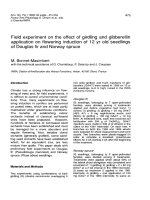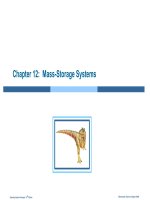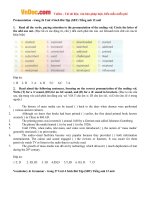Experiment 12 molar mass
Bạn đang xem bản rút gọn của tài liệu. Xem và tải ngay bản đầy đủ của tài liệu tại đây (126.67 KB, 6 trang )
Name: Ngo Dang Quang Hieu
Trieu Vinh Khang
Dinh Xuan Phuoc
Duong Khac Trieu
22125084
22125112
22125226
22125333
Experiment 12 Report Sheet
Molar Mass of a Volatile Liquid
A. Preparing the Sample
Unknown number:
A (Ethanol)
Trial 1
1. Mass of dry flask, foil, and rubber band (g)
Trial 2
Trial 3
76.36(g)
B. Vaporize the Sample
1. Temperature of boiling water (oC, K)
98.5 oC
93 oC
95 oC
2. Mass of dry ask, foil, rubber band and vapor (g)
76.63(g)
76.53(g)
76.72(g)
C. Determine the Volume and Pressure of the Vapor
1. Volume of 125 mL flask (L)
168.00(mL)
100+20+ 48=Total volume
2. Atmospheric Pressure (torr, atm)
1.00(atm)
D. Calculations
1. Moles of vapor, nvapor (mol)
6.54 x 10−3 (mol)
2. Mass of vapor, mvapor (g)
3. Molar mass of compound (g/mol)
0.27(g)
0.17(g)
0.36(g)
41.28(g/mol)
25.99(g/mol)
55.04(g/mol)
4. Average molar mass (g/mol)
40.77(g/mol)
5. Standard deviation of molar mass
6.
14.53
Relative standard deviation of molecular mass
(%RSD)
Calculations for RSD:
S t andard Deviation=
%RSD=
√
∑ ( x− x´ )
n−1
2
=
√
35.63%
( 41.28−40.77 )2 + ( 25.99−40.07 )2 + ( 55.04−40.77 )2
=14.53
3−1
Standard Deviation
14.53
x 100 %=
x 100=35.63 %
Arverage molar mass
40.77
1
Class data/group
Molar mass
Sample unknown no.
1
2
3
4
5
6
41.28
25.99
55.04
81.04
48.92
67.27
A. Preparing the Sample
Unknown number: B (Acetone)
Trial 1
2. Mass of dry flask, foil, and rubber band (g)
Trial 2
Trial 3
76.49(g)
B. Vaporize the Sample
3. Temperature of boiling water (oC, K)
4. Mass of dry ask, foil, rubber band and vapor (g)
96 oC
93 oC
98.5 oC
77.02(g)
76.81(g)
76.93(g)
C. Determine the Volume and Pressure of the Vapor
3. Volume of 125 mL flask(L)
168.00(mL)
100+20+ 48=Total volume
4. Atmospheric Pressure (torr, atm)
1.00(atm)
D. Calculations
7. Moles of vapor, nvapor (mol)
6.54 x 10−3 (mol)
8. Mass of vapor, mvapor (g)
9. Molar mass of compound (g/mol)
0.53(g)
0.32(g)
0.44(g)
81.04(g/mol)
48.92(g/mol)
67.27(g/mol)
10. Average molar mass (g/mol)
65.74(g/mol)
11. Standard deviation of molar mass
16.11
12. Relative standard deviation of molecular mass
(%RSD)
Calculations for RSD:
Standard Deviation=
%RSD=
√
∑ ( x−´x )
n−1
2
24.50%
( 81.04−65.74 )2+ ( 48.92−65.74 )2+ ( 67.27−65.74 )2
=
=16.1 1
3−1
√
Standard Deviation
1 6.11
x 100 %=
x 100=24.50 %
Arveragemolar mass
65.74
Laboratory Answers
1. Part A.1. The mass of the flask (before the sample is placed into the flask) is measured when
the outside of the flask is wet. However, in Part B.3, the outside of the flask is dried before
its mass is measured.
2
a. Will the mass of vapor in the flask be reported as too high or too low, or will it be
unaffected?
The mass of vapor in the flask be reported will too high by when subtracting the mass of the dry flask,
foil, rubber band from the mass of dry flask, foil, rubber band and vapor, the first part will be much
higher because of the wetness, so it'll seem as though there was a greater mass of vapor than there was
b. Will the molar mass of the vapor in the flask be reported as too high or too low or will it be
unaffected?
The molar mass of the vapor in the flask be reported will too high; when calculating molar mass
there'll be a much higher grams than there was supposed to be.
2. From the time the mass of the flask is first measured in Part A.1 until the time it is finally
measured in Part B.3, it is handled a number of times with oily fingers. Does this lack of
proper technique result in the molar mass of the vapor in the flask being reported as too
high or too low or as unaffected?
The molar mass of the vapor in the flask being reported as too high since the oil from the fingers will
increase the amount of mass overall on the flask, and during calculations it'll seem like there a greater
mass of vapor than there actually is.
3. Part B.2. The flask is completely filled with vapor only when it is removed from the hot
water bath in Part B.3. However, when the flask cools, some of the vapor condenses in the
flask. As a result of this observation, will the reported molar mass of the liquid be too high,
too low, or unaffected?
The reported molar mass of the liquid will be unaffected because the mass of the vapor should be
equivalent to the mass of the vapor that condenses.
4. Part B.2. Suppose the thermometer is miscalibrated to read 0.3°C higher than actual. Does
this error in calibration result in the molar mass of the vapor in the flask being reported as
too high, too low, or as unaffected? Explain.
The molar mass of the vapor in the flask being reported as too high by when calculating moles of
vapor using PV =nRT if the temperature is too high then the calculated mole will be too low. Then when
you divide the mass by these too low moles then the molar mass will be too high
5. Part C.1. If the volume of the flask is assumed to be 125ml instead of the measured volume,
would the calculated molar mass of the unknown liquid be too high, too low, or unaffected
by this experimental error? Explain.
The calculated molar mass of the unknown liquid will be too high as when calculating moles of vapor
using PV =nRT if the volume is too low then the calculated moles will be too low. Then when you divide
the mass by these too low moles then the molar mass will be too high.
6.
The pressure reading from the barometer is recorded higher than it actually is. How does
this affect the reported molar mass of the liquid: too high, too low, or unaffected? Explain.
The reported molar mass of the liquid will too low because if calculate moles of vapor using
PV =nRT if the pressure if too high then the calculated moles will be too high. Then when you divide
the mass by these too high moles then the molar mass will be too low.
3
4
Experiment 2 Prelaboratory Assignment
Molar Mass of a Volatile Liquid
1. The following data were recorded in determining the molar mass of a volatile liquid following
the Experimental Procedure for this experiment.
Mass of dry ask, oil, and rubber band (g)
74.722
Temperature of boiling water (℃, K), K)
98.7
Mass of dry ask, foil, rubber band and vapor (g)
74.921
Volume of 125 mL ask (L)
0.152
Atmospheric pressure (torr, atm)
752
a. How many moles of vapor are present?
We have:
P=
752
=0.989 atm
760
V = 0.152 L
T=371.85 ° K
R = 0.08206
n=
PV
= 4.92x 10-3 mol
RT
b. What is the molar mass of the vapor?
Mass of vapor: 0.199g
Molar mass =
0.199
= 40.36 g/mol
4.92 x 10−3
2.
a. If the atmospheric pressure of the flask is assumed to be 760 torr in question 1, what is the
reported molar mass of the vapor?
n=
PV
1 x 0.152
=
= 4.98 x 10-3
RT 0.08206 x 371.85
Molar mass of vapor =
0.199
=39.94 g/mol
4.98 x 10−3
b. What is the percent error caused by the error in the recording of the pressure of the vapor?
%erro r =
M differnce
40.36−39.94
x 100=
x 100=1.04 %
Mactual
40.36
5
3. The ideal gas law equation (equation 12.1) is an equation used for analyzing ideal gases.
According to the kinetic molecular theory that defines an ideal gas, no ideal gases exist in
nature, only real gases. Van der Waals’ equation is an attempt to make corrections to real gases
that do not exhibit ideal behavior. Describe the type of gaseous molecules that are most
susceptible to nonideal behavior.
According to the ideal gas law, no intermolecular attraction exists between the gas molecules and the
specific size of the gas molecules is negligible compared to the overall volume occupied by the gases.
For example, polar gases that can have stronger dipole-dipole interactions often behave less ideally
than nonpolar gases. Larger gases are also susceptible to the non-ideal state because the specific volume
of the gas becomes more significant.
4.
a. How is the pressure of the vaporized liquid determined in this experiment?
Pressure of liquid vaporized = Atmospheric pressure – water vapor pressure at that temperature.
b. How is the volume of the vaporized liquid determined in this experiment?
Filling the Erlenmeyer flask with water, then the volume of the flask is measured by transferring the
water into the graduated tube.
c. How is the temperature of the vaporized liquid determined in this experiment?
After the water boils slightly, the temperature is recorded with a thermometer.
d. How is the mass of the vaporized liquid determined in this experiment?
Let cool until room temperature, then dry the outside with a scale.
e. The molar mass of a compound is measured to be 30.7, 29.6, 31.1 and 32.0 g/mol in four
trials.
a. What is the average molar mass of the compound?
30.85 g/mol
b. Calculate the standard deviation and the relative standard deviation (as %RSD) for the
determination of the malar mass.
The Standard Deviation = 0.86
%RSD =
standard deviation
0.86
=
= 27.8%
the average molar mass 30.85
6









